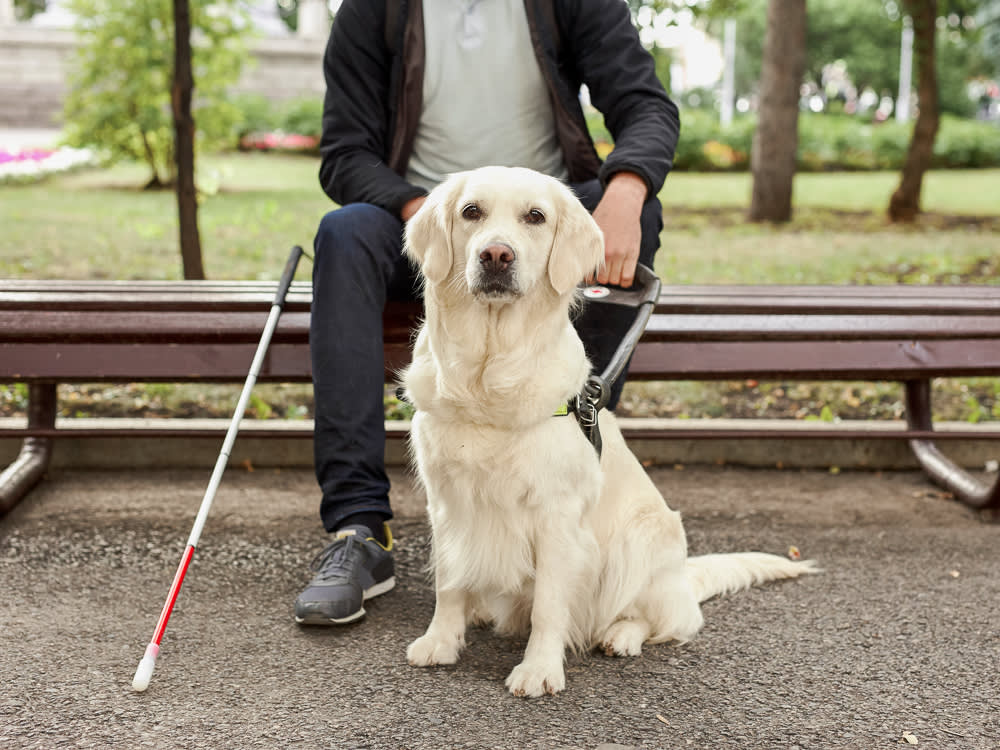Misconceptions About Assistance Dogs and Their Remarkable Partners
No, you can’t stroke them when their human isn’t looking

share article
If you see an assistance dog walking down the street, you definitely want to stroke that good boy or girl, but you definitely know you are not supposed to do that. As much as we want to praise these perfect dogs for doing a perfect job, we have to shower them with our undying love from afar. Here are some things you should know about assistance dogs.
Why do people have assistance dogs?
Of course we love them, but what precisely is the purpose of assistance dogs? Why are assistance dogs important? These days, there are still many misconceptions surrounding assistance dogs, including who can have them and what they do. Here, we debunk 10 of the most common ones.
1. Are emotional support animals the same as assistance dogs?
Here are the facts about emotional support animals and how they’re (legally) different than assistance dogs: An emotional support animal (ESA dog) is a pet who emotionally supports their handler. In the UK, they are not legally recognised – unlike the US where they are allowed to live in no-pets-allowed housing. Until January 2021, emotional support animals in the US were allowed to fly in the cabin of a plane free of charge. But due to some incidents by people claiming that their pets were emotional support animals, from llamas to peacocks, US airlines will now only offer free, unconfined rides to assistance dogs and certified psychiatric service dogs (PSDs).
An assistance dog, however, is considered to be an ‘auxiliary aid’, not a pet. They are as necessary as say, a wheelchair or insulin pump. Assistance dogs must be specifically trained to do work or tasks relating to the mitigation of a person’s disability. Simply offering emotional support and comfort or having a calming effect doesn’t quite fit the bill.
2. Are assistance dogs always wearing vests or identifiable gear?
Despite many sites that claim their products (assistance dog tags, certificates or vests) are not only legitimate, but mandatory, in the UK there is actually no such thing as a legitimate identification card or certificate that ‘proves’ a dog is a trained assistance dog. Many assistance dogs will be members of Assistance Dogs UKopens in a new tab (ADUK) and have an ID booklet from them. Assistance dogs will likely wear gear that identifies them as such, but only dogs that have been trained by ADUK will be issued branded dog gear. It is not a legal requirementopens in a new tab for assistance dogs to wear gear identifying them.
3. Are assistance dogs only for blind people?
It used to be the case many years ago that there were only assistance dogs for Blind people, and for Deaf people. But things have changed dramatically. Today, assistance dogs are employed by people with mental illnesses, autism, epilepsy, diabetes and countless other conditions – anything that affects the person’s capacity to perform at least one major life task. The dog’s purpose is to help the person be more independent.
4. Does training only take a few months?
Technically speaking, training never ends. Assistance dogs must be able to learn new skills and adapt to their handlers’ needs as they change over time. Additionally, it is not uncommon for fully trained dogs to need brush up on things they’ve already learnt how to do. Initially though, it takes about two years to train an assistance dog.
5. Can assistance dogs be any breed or size?
Dogs of any breed, shape or size can potentially be an assistance dog, provided they are healthy, have a stable temperament and can be trained to do the necessary work. Many non-traditional breeds – shelter dogs and bully breeds included – make amazing assistance dogs.
6. Do assistance dogs know if people are carrying drugs?
Can an assistance dog smell drugs? Probably. Will they bark? Not likely. Assistance dogs and detection dogs are trained to respond to completely different things. The only person an assistance dog focuses on is their handler.
7. Is it OK to stroke an assistance dog (if the handler isn’t looking)?
It’s important to understand why you can’t pet an assistance dog: in the assistance-dog community, people who do this are called ‘drive-by petters’. They wait for the handler to look away, then stroke the dog as they walk by. Not only is this disrespectful, it’s also distracting to the dog, who needs to be focused on working.
8. Do people with assistance dogs want to chat?
No offence, but no, they don’t. They usually just want to, say, get milk at the supermarket and go home rather than indulge a stranger’s curiosity. Just because they have an assistance dog that doesn’t mean they want to share their life story. The next time you see an assistance dog team out and about, ignore the dog and go about your business – allowing them to go about their business, too.
9. Can businesses require people with assistance dogs to prove they need them?
According to the Equality and Human Rights Commissionopens in a new tab, it would be unlawful to refuse a service to a disabled person accompanied by an assistance dog except in the most exceptional circumstances. There aren't specific rules on what business owners are allowed to ask but it is unlawful to treat someone unfavourably because of something connected to their disability or to treat someone in a way that makes them feel humiliated, offended or degraded for reasons related to their disability.
10. Can assistance dogs accompany their handlers everywhere?
Being a working assistance dog is arguably one of the best lives a dog could have. They’re able to be with their handlers almost all the time, no matter where they go. They have a job and a purpose, which dogs thrive on. Plus, most get a higher quality of care than many humans. Separation anxiety? I don’t know her!
Frequently asked questions
What is an assistance dog?
The UK governmentopens in a new tab defines an assistance dog as dogs that have been trained in order to provide assistance to disabled people or those with certain medical conditions.
What to do if an assistance dog approaches you without their owner?
If an assistance dog approaches you with no handler in sight, it’s a clue that the dog is seeking help. Follow the dog. They will lead you to their handler. Identify the situation, and if necessary, call 999 immediately.
What is the difference between an assistance dog or emotional support dog?
An assistance animal means any dog that is individually trained to do work or perform tasks for the benefit of an individual with a disability. Support dogs do not have special training to perform tasks that assist people with disabilities.
References

Kaelynn Partlow
Kaelynn Partlow was diagnosed with autism and learning disabilities as a child; as an adult, she is a therapist working with autistic children. At Assistance Dogs of the Carolinas, she teaches people with disabilities to train their own service dogs.
Related articles
![Asian baby at home with howling dog]() opens in a new tab
opens in a new tabWhy Your Dog Howls When Your Baby Cries
Is your dog showing empathy? Or just plain annoyance?
![A dog laying on a couch looking relaxed]() opens in a new tab
opens in a new tabIs Your Dog Sad?
Or are they just peacefully resting? Behaviourist Karen London explains how to tell the difference
- opens in a new tab
On the Autism Spectrum? Consider Getting a Dog
Dr Annie Bowes, a vet on the spectrum, explains: “Dogs sense the world like we do, and don’t judge us”
![A woman holding a dogs paw and smiling.]() opens in a new tab
opens in a new tabNine Useful Tricks to Teach Your Dog
Go beyond the basics






